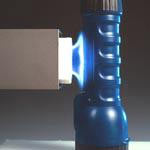Researchers at Purdue University have demonstrated a new technology that employs "ionic wind engines" to cool chips as much as five times more effectively than other experimental cooling approaches, the institution reports.
In their testing, researchers found that the technology reduced heating from about 140 degrees Fahrenheit to about 95. This kind of cooling technology could help hardware makers develop thinner, more powerful laptops, according to Purdue. (I imagine it could also show up in server hardware.)
"In computers and electronics, power equals heat, so we need to find ways to manage the heat generated in more powerful laptops and handheld computers," said Timothy Fisher, associate professor of mechanical engineering at Purdue.
According to Purdue, the cooling technology could appear in computers in the next three years -- if researchers are able to reduce the size of components within the device from the scale of millimeters to microns, or millionths of a meter. They'll also have to figure out how to make the system sufficiently rugged.
"As things get smaller, they get more delicate, so we need to strengthen all the elements. And we believe we can achieve this goal in a year or so," said Suresh Garimella, a professor of mechanical engineering at Purdue.
Down the road, it could also show up in portable devices such as cell phones.
The technology uses tiny "ionic wind engines" to achieve its supercool chilling effect. Here's how Purdue explains it: The device contains a positively charged wire, or anode, and negatively charged electrodes, called cathodes. When voltage passes through the device, the negatively charged electrodes discharge electrons toward the positively charged anode. Along the way, the electrons collide with air molecules, producing positively charged ions, which were then attracted back toward the negatively charged electrodes. This creates the "ionic wind," which increases the airflow on the surface of the experimental chip.
The research, funded by Intel, was conducted and documented in a paper by Fisher, Garimella, mechanical engineering doctoral student David Go, and Intel research engineer Rajiv Mongia. Specifics about the research will appear in the Journal of Applied Physics, tentatively scheduled for the Sept. 1 issue.

